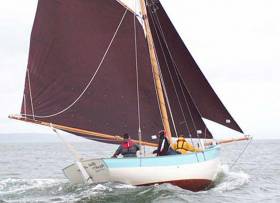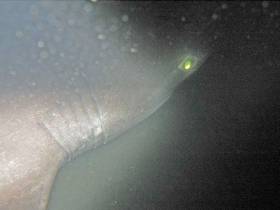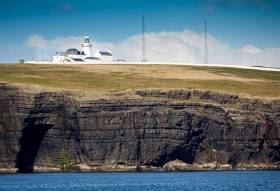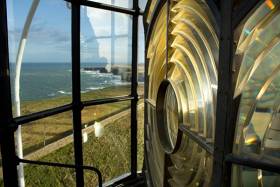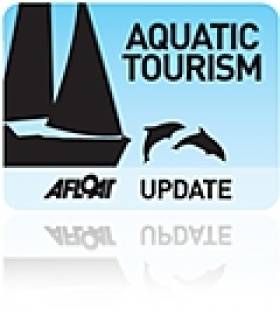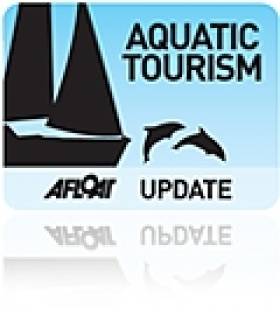Displaying items by tag: Loop Head
Shannon Estuary's Loop Head Lighthouse Hosts Annual International Lighthouse and Lightship Weekend
Amateur radio enthusiasts from across Ireland's midwest gathered at Loop Head Lighthouse Experience on the Shannon Estuary in County Clare over the weekend to participate in the 26th annual International Lighthouse and Lightship Weekend (ILLW). The event, which saw the Limerick Clare Radio Amateur Club broadcast non-stop for 48 hours from the West Clare lighthouse, involved using Morse Code and Single Sideband Radio to contact lighthouses and lightships around the world.
The Limerick Clare Radio Amateur Club has had great success in previous years, having contacted fellow radio amateurs in countries such as Australia, Brazil, and the US Virgin Islands. During this year's broadcast, visitors to the lighthouse were able to listen in on communications with some of the 500 lighthouses and lightships in over 40 countries that were activated by amateur radio enthusiasts.
Loop Head Lighthouse is an ideal location for long-distance radio communication attempts due to its isolated location on the edge of the Atlantic Ocean and the lack of radio interference in the general area. The Club operated two stations during the weekend, one of which was at the entrance to the Lighthouse so members of the public could listen to some of the transmissions.
 Loop Head Lighthouse is one of 17 Great Lighthouses of Ireland and has become one of West Clare's most popular attractions since it first opened to visitors in 2011
Loop Head Lighthouse is one of 17 Great Lighthouses of Ireland and has become one of West Clare's most popular attractions since it first opened to visitors in 2011
Joe Ryan, Secretary of the Limerick Clare Amateur Radio Club, expressed his gratitude to all the staff of Clare County Council and the Commissioners of Irish Lights for their help in planning the event and allowing them to use the grounds as part of the International Lighthouse and Lightships Weekend.
Loop Head Lighthouse Experience is one of 17 Great Lighthouses of Ireland and has become one of West Clare's most popular attractions since it first opened to visitors in 2011. The lighthouse also serves as one of two Signature Discovery Points in County Clare along the route of the Wild Atlantic Way.
Overall, the event was a great success and brought together radio enthusiasts from all over the world to share their love of communication and lighthouses.
See here for more information on the International Lighthouse and Lightships Weekend
Shannon Estuary Cutter Sally O’Keeffe Brings Focus to Loop Head Peninsula
Though it may not look it on a map which emphasises the extensive low water limits, at high water the Loop Head Peninsula in southwest County Clare is almost an island writes W M Nixon.
Only a couple of small roads lead into it from the main road between Kilrush and Kilkee, and once you’re into the Loop, you’re in a different country, a distinctive place with its own strong sense of identity.
It was here in Querrin that a voluntary group got together some years ago to build a boat to commemorate the small Shannon sailing hookers which were once the Loop Head Peninsula’s most important transport link for goods coming down the long estuary from Limerick.
 Loop Head Peninsula – a world apart with Carrigaholt at its heart
Loop Head Peninsula – a world apart with Carrigaholt at its heart
This local community group only had some ancient photos and sketches - and some vague old memories - to go by. But, guided by shipwright Steve Morris of Kilrush, they had naval architect Myles Stapleton of Malahide to bring his considerable talents to the task, and he created a wonderfully characterful 25-footer which looks good from any angle, sails well too, and can carry significant numbers to avail of Seol Sionna’s enthusiasm for spreading seagoing awareness. They’ve fresh plans afoot for 2018, and have sent us this cheerful message:
“Sally O’Keeffe, the traditional wooden sail training vessel based on the Shannon Estuary, is currently gearing up for her seventh season on the ocean, and is putting a shout out to any and all who would wish to sail on her.
The 25-foot gaff rigged cutter was built by community group “Seol Sionna” under the guidance and tuition of local professional shipwright Steve Morris from plans drawn up by naval architect Myles Stapleton. Launched in Querrin in 2012 just 200 metres from where she was built, this craft has become one of the busiest and most capable sailing vessels on the Estuary.
 The design of Sally O’Keeffe was neatly judged to provide the maximum on-board space Photo: W M Nixon
The design of Sally O’Keeffe was neatly judged to provide the maximum on-board space Photo: W M Nixon
Seol Sionna offer a “traditional seafaring skills” course on board Sally O’Keeffe each summer, taking participants through all stages of sailing to competent crew level. This is hands-on training - there are no winches or clutches, and the only buttons onboard are the chocolate ones that the skippers love! The atmosphere is fun and relaxed, but with a strong emphasis on safety.
On top of training, regular weekly sailing trips are made to various regions on the glorious estuary, picnics/walks/ birdwatching to Scattery Island, a jaunt to Carrigaholt for a pint and chowder, or out to Loop Head for a spot of fishing, for this is truly a versatile fun boat.
Over the past seven years, Sally (she’s named after the long-ago publican’s wife of Querrin) has shown her pedigree by sailing to and participating in traditional boat festivals in Baltimore and Glandore. There, she has taken first prize in her class on both occasions, confirming that she not only looks good, but sails well too.
This year’s plans are being finalised for taking Sally on a cruising trip up the west coast, taking in the Aran Islands and Inishbofin and calling in on Crinniú na Mbád in Kinvara on the way home.
Anyone interested in becoming a member can do so as a family, individual or concession for €60, €40, and €20 respectively. Training to competent crew level costs only €70, while daily membership is also available.
 Carmody’s Bar, Carrigaholt – gather here on the night of Friday 23rd February to learn about Seol Sionna and Sally O’Keeffe
Carmody’s Bar, Carrigaholt – gather here on the night of Friday 23rd February to learn about Seol Sionna and Sally O’Keeffe
For more information, why not come along to Carmody's Bar at Carrigaholt on the 23rd February? There, a table quiz to raise funds for Seol Sionna will take place, and you may even win a free trip or two. Otherwise, check out Seol Sionna on Facebook or contact Fintan 087 2266501, Steve 087 7990091, or Richard 087 6744550.
And may you have fair winds and following seas.”
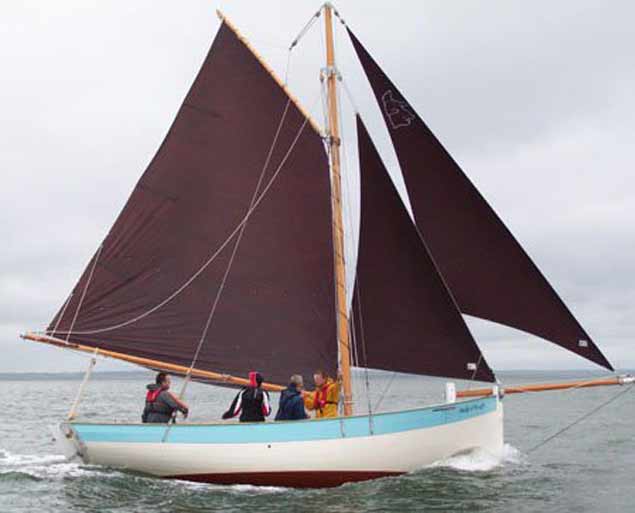 Community-built in Querrin on the Loop Head Peninsula, Sally O’Keeffe is a stylish design by Myles Stapleton.
Community-built in Querrin on the Loop Head Peninsula, Sally O’Keeffe is a stylish design by Myles Stapleton.
Sea Anglers Hook 'Record' Sixgill Shark Off Clare Coast
#Angling - A group of sea anglers off the Co Clare coast have hooked what’s thought to be the largest ever sixgill shark caught by rod and line in Europe.
As BBC News reports, English angler Ben Bond struggled for 90 minutes to reel in the 7.5m monster shark, which was photographed for record before being unhooked and released.
“Watching it swim away was probably the best part, I wouldn't want to kill such an impressive creature,” said Bond, who added he was thrilled by the experience off Loop Head last Thursday 4 May.
Though the shark was not weighed, Fishing in Ireland estimates it to be over 1,500lbs — more than 50% larger than a similar shark caught from the same boat off Co Clare just two days before.
BBC News has more on the story HERE.
Loop Head Lighthouse Visitor Numbers Up (Again) in 2016
A record number of people visited Loop Head Lighthouse on the Shannon Estuary in County Clare during 2016.
Figures from Clare County Council show that 27,274 people visited the lighthouse during the opening period up to Sunday 2 October compared to 27,010 during the same period in 2015.
The increase in visitors represents the fifth successive annual increase in visitor numbers at the West Clare landmark.
Clare County Council, which manages the Lighthouse in conjunction with the Commissioner of Irish Lights (CIL), first opened the popular visitor attraction to the public in 2011.
Loop Head Lighthouse, which is steeped in history and rich in maritime heritage with its origins dating back to the 1670s, is a landmark location on the Loop Head Heritage Trail. It is also one of two Signature Discovery Points in County Clare along the route of the Wild Atlantic Way and is one of 12 Great Lighthouses of Ireland that won a Silver award this week at the Responsible Tourism Awards.
Caravan Park Visitors Help Rescue Dolphins From Loop Head Beach
#MarineWildlife - Holidaymakers on the Loop Head Peninsula sprang into action to rescue two common dolphins stranded on a nearby beach, as the Irish Examiner reports.
Visitors staying at Doonaha's Green Acres caravan park used buckets of water to keep the mother and calf wet and tarps to help lift them into deeper waters off the rocky shore before a team from Shannon Dolphin and Wildlife Foundation arrived.
The Irish Examiner has more on the story HERE.
Historic Loop Head Lighthouse Reopens to Public this Weekend
Loop Head Lighthouse in West Clare, one of the Great Lighthouses of Ireland, will reopen to the public this Saturday (March 12th 2016).
Clare County Council, which manages the facility in conjunction with the Commissioners of Irish Lights (CIL), says the historic lighthouse will remain open daily (10am-6pm) until October 2nd.
The popular tourist attraction attracted 26,932 visitors during 2015. The figure represents an increase of 6,564 or 32% on 2014 visitor numbers.
Loop Head Lighthouse is a landmark location on the Loop Head Heritage Trail which was named winner of the 'Culture and Heritage' category of the 2015 World Responsible Tourism Awards. It is also one of twelve lighthouses which make up Great Lighthouses of Ireland, a new all-island tourism initiative, and is one of two Signature Discovery Points in County Clare along the route of the Wild Atlantic Way.
Cllr. James Breen, Cathaoirleach of Clare County Council said the lighthouse has become "a key driver" of visitor numbers to the Loop Head Peninsula since it was first opened to the public in 2011.
He added, "Loop Head Lighthouse truly is one of the tourism success stories for County Clare in recent years. It has helped to strengthen the profile, both nationally and internationally, of the wider Loop Head Peninsula and what it has to offer as a tourism destination. Its promotion as a Signature Discovery Point along the route of the Wild Atlantic Way has also ensured that the attraction has been promoted both in Ireland and overseas, which is reflected in the origin of visitors."
Almost half of the total visitor figure during 2015 was represented by Irish visitors, with Germany, North America, UK, France and Italy collectively accounting for more than 42% of the overall figure.
Loop Head Lighthouse, located at the mouth of the Shannon Estuary, is steeped in history and rich in maritime heritage with its origins dating back to the 1670s. The existing tower style lighthouse was constructed in 1854 and was operated and maintained by a keeper who lived within the lighthouse compound. In January 1991, the lighthouse was converted to automatic operation, and today is in the care of an attendant and is also monitored by the CIL.
Admission to Loop Head Lighthouse, which includes the exhibition and guided tour of the site, is Adults (€5), Children (Under 14 - €2) and Family Passes for up to 2 adults + 3 children (€12). Visit www.loophead.ie or www.clare.ie for more information on Loop Head Lighthouse and the Loop Head Peninsula.
Anne Doyle Launches Tourist Season at Loop Head Lighthouse
#loophead – Former RTE newsreader and lighthouse enthusiast, Anne Doyle was in West Clare today where she joined Councillor John Crowe, Cathaoirleach of Clare County Council, in launching Loop Head Lighthouse's 2015 tourist season.
The historic landmark commenced its 5th year of operations when it reopened to the public on 03 April last. Clare County Council, which manages Loop Head Lighthouse in conjunction with the Commissioners of Irish Lights (CIL), says the facility will remain open daily (10am-6pm) until 4th October 2015.
Anne Doyle has been captivated by lighthouses since her childhood in Ferns, County Wexford, where she grew up observing the sweeping lights of the Tuskar Rock Lighthouse.
"Ireland's lighthouses hold so much history and are located in some of Western Europe's most scenic settings. Loop Head is no exception and the location of the lighthouse on the tip of the majestic Loop Head Peninsula and at the mouth of the Shannon Estuary makes it extra special," said Ms. Doyle.
Commenting on the launch of the 2015 visitor season, Councillor John Crowe said: "The 19th century West Clare landmark will be looking to capitalise on its designation as a Signature Discovery Point on the Wild Atlantic Way and further promote the economic development of the Loop Head Peninsula."
"Visitor numbers at the lighthouse have continued grow year on year since it was first opened to the public in 2011. During this time the lighthouse has delivered a major boost to economic activity in the wider area and I am confident it will further build on this in the months and years ahead," he added.
Loop Head Lighthouse is steeped in history and rich in maritime heritage with its origins dating back to the 1670s. The existing tower style lighthouse was constructed in 1854 and was operated and maintained by a keeper who lived within the lighthouse compound. Taoiseach Enda Kenny's grandfather was a keeper at the lighthouse. James John McGinley took up duty at the Lighthouse as Principal Keeper on 16th January 1933. He spent 1 year and 10 months at Loop Head. He was transferred from the station in October 1934.
Located to the rear of the lighthouse is an Éire sign etched into the headland, which was used to alert passing Allied aircrews that they were passing over neutral Ireland during World War Two.
In January 1991, the lighthouse was converted to automatic operation, and today is in the care of an attendant and is also monitored by the CIL.
Loop Head Landmark Lights up the Wild Atlantic Way
#loophead – The historic Loop Head Lighthouse reopens to the public this Friday. The 19th century West Clare landmark will be looking to capitalise on its designation as a Signature Discovery Point on the Wild Atlantic Way by exceeding the 20,368 visitors it recorded during its six-month opening period during 2014.
Clare County Council, which manages Loop Head Lighthouse in conjunction with the Commissioners of Irish Lights (CIL), says the facility will remain open daily (10am-6pm) until 4th October 2015.
"2014, which was the lighthouse's fourth year of operation as a visitor attraction, saw visitor figures buoyed by the development of new services at Shannon Airport, favourable weather conditions and the launch of the Wild Atlantic Way," said Gerard Dollard, Director of Services, Tourism & Community, Clare County Council.
"We are confident that its status as one of Clare's most popular visitor attractions as well as a Signature Discovery Point on the Wild Atlantic Way will garner further interest from domestic and international visitors alike. Over its five years of operation the lighthouse project has been a major boost to economic activity in the wider area and we would hope to further build on this" added Mr. Dollard.
61% of the total visitor figure for 2014 was represented by Irish visitors, with North America, the United Kingdom and Germany each accounting for 8% of the overall figure. Italian and French visitors meanwhile, represented just over 5% of the total figure.
Loop Head Lighthouse, located at the mouth of the Shannon Estuary, has origins dating back to the 1670s. The existing tower style lighthouse was constructed in 1854 and was operated and maintained by a keeper who lived within the lighthouse compound.
Loop Head Named As Top Sustainable Tourism Destination
#Tourism - Loop Head Peninsula has been named as one of the world's top 100 sustainable travel destinations, as The Irish Times reports.
The breathtaking Clare coastal spot is featured with the likes of the UK's Lake District and New Forest, Easter Island in the Pacific and the Wild Coast in South Africa's Eastern Cape in the first Sustainable Destinations Global Top 100 travel guide.
The Irish Times has more on the story HERE.
Wild Atlantic Way Heritage Tourism Project Launched
#WAW – A pilot project that has resulted in the development of a heritage trail on 60km of the Wild Atlantic Way (WAW) is being hailed as a template for future similar developments along the West of Ireland coastal route from Donegal to West Cork.
Clare County Council, in partnership with Loop Head Tourism, The Heritage Council and Fáilte Ireland, today launched the Loop Head and Kilkee Heritage Trail on the Wild Atlantic Way.
The guide features 18 local heritage attractions including the West Clare Railway, the Church of the Little Ark, Kilkee Victorian Town and the Bridges of Ross, as well as other local WAW Discovery and Signature Points.
Through consultation with the local community and stakeholders, the pilot project also features recommendations to make it more streamlined and cost effective for other local communities to replicate the same project along the 2,500km WAW.
Cllr. John Crowe, Cathaoirleach of Clare County Council welcomed the selection of Kilkee and the Loop Head Peninsula as the location for the pilot project and said he hoped other WAW communities will be inspired to further enhance their tourism product offering.
He added: "The development and promotion of lesser known attractions is often overlooked even though they hold the key to revitalising the domestic tourism sector. The Loop Head Peninsula boasts a variety of local heritage sites and attractions, along with some of Ireland's most unique and breathtaking scenery. The development of this Trail complements work undertaken throughout the Loop Head Peninsula in recent years to develop and promote the local tourism product."
Congella McGuire, Heritage Officer with Clare County Council said Loop Head's growing reputation as a visitor destination has evolved as a result of "a bottom-up, community focused approach."
"The project is aimed at promoting a greater sense of understanding of the history, heritage, folklore and culture along the Wild Atlantic Way (WAW) route by connecting with and placing the local community at the core of this and future WAW projects," she said.
Ms. McGuire noted that a systematic project methodology was used in the development of the heritage trail.
"The first key task was the identification of potential heritage trail sites by the project steering group and key community representatives. An inspection of each of the 27 potential heritage sites was undertaken where a set of site assessment criteria were applied and this potential list was refined. This was followed by research and interpretation tasks surrounding the 18 sites on the final list and the Maritime History, Folklore and Traditions, Flora and Fauna, and Built, Military and Religious Heritage of the area," she commented.
Ms. McGuire continued: "The recommendations, processes and checklists outlined in the final project report should allow the project to be replicated and help future projects be more efficient, streamlined and cost effective. They also provide a clear model for working with the local community and stakeholders and will help deliver high quality and consistent design ready interpretation content along the entire WAW."
Cillian Murphy, Chairperson of Loop Head Tourism commented: "We are delighted to have had this opportunity to work with The Heritage Council, Failte Ireland and Clare County Council on developing the first destination led heritage trail on the WAW. It is testament to the hard work done by the group over the last number of years that we were chosen to be the pilot project on how to showcase our local heritage to visitors, enticing them to slow down and spend a little longer in each destination along the Wild Atlantic Way."
"The resulting Loop Head Peninsula Heritage Trail is a shining example of what can be achieved when statutory agencies and local community groups co-operate in a bottom up approach to tourism development. County Clare has placed itself at the forefront of responsible tourism development in Ireland over the last number of years and this project is further proof of that decision paying dividends and benefiting both locals and visitors alike," added Mr. Murphy.
The Loop Head and Kilkee Heritage Trail on the Wild Atlantic Way features Carrigaholt Castle and Bay, Bridges of Ross, Kilkee Cliffs and Pollock Holes (WAW Discovery Points), Church of the Little Ark (WAW Signature Point), Blackweir Bridge, Doonaha Ringforts, Tullig Famine Village, Corbally and Coosheen (Heritage Areas), Bishops Island, Dunlicka Castle, Loop Head, Pilots Memorial and Kilbaha Bay, Grave of the Yellow Men, Rinevella Bay and Submerged Forest, Kilcredaun Churches and Holy Well, Kilcredaun Churches and Holy Well, Querrin Pier and the West Clare Railway (Heritage Sites).
The Trail Z-Card will shortly be made available throughout the region.


























